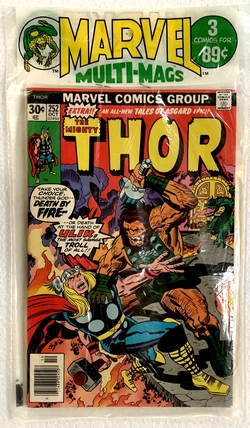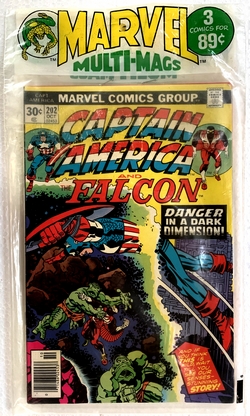 |
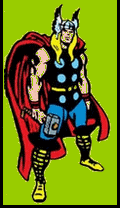 |
|
THOR,
THE ETERNALS & CAPTAIN
AMERICA
BACK
TO BACK IN A
OCTOBER
1976 MARVEL MULTI-MAGS
|
|
|
|
| |
|
| |
|
| |
|
| |
MARVEL
MULTI-MAGS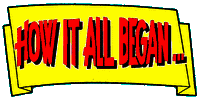 |
|
Even in the early
1960s, the comic book industry
realized that in spite of the
hugely successful comeback of the
superhero genre (which had been
clinically dead for most of the
1950s) and the subsequent streak
of new creativity and enthusiasm
it generated, its traditional
sales points were fading away.
Small stores that had carried
comic books were pushed out of
business by larger stores and
supermarkets, and newsagents
started to view the low
cover prices and therefore tiny
profit margins comics had to
offer as a
nuisance. Many ideas on how
to turn these developments around
were put forward by different
publishers, but the most
successful concepts strived to
open up new sales opportunities
and markets and thus tap into a
new customer base.
|
|
|
|
| |
| One place
these potential buyers could be found was the growing
number of supermarkets and chain stores. But in order to
be able to sell comic books at supermarkets, the product
would have to be adjusted. |
| |
|
Handling
individual issues clearly was no option for these
outlets, but by looking at their logistics and
display characteristics, DC Comics (who came up
with the Comicpac concept in 1961) found
that the answer to breaking into this promising
new market was to simply package several comic
books together in a transparent plastic bag. This
resulted in a higher price per unit on sale,
which made the whole business of stocking them
much more worthwhile for the seller. The simple
packaging was also rather nifty because it
clearly showed the items were new and untouched,
while at the same time blending in with most
other goods sold at supermarkets which were also
conveniently packaged. |
|
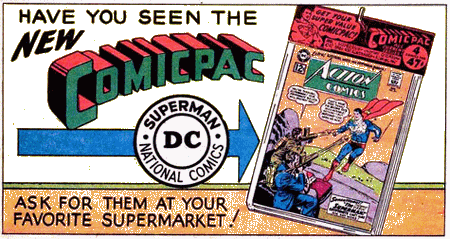 |
|
| |
| Outlets were even supplied with
dedicated Comicpac racks, which enhanced the
product appeal even more since the bags containing the
comic books could be displayed
on rack hooks in an orderly and neat fashion. |
| |
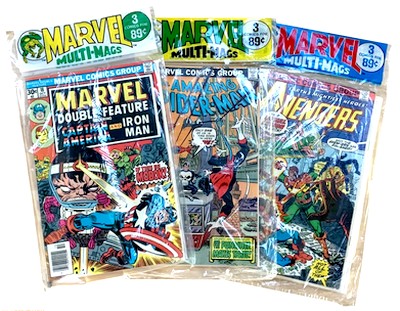
|
|
DC's
"comicpacks" were a success -
so much so that other publishers quickly
started to copy it. Marvel produced a
series of Marvel Multi-Mags in
1968/69 but then seems to have dropped
the idea again.
However,
by the mid-1970s, the House of
Ideas had once again fully embraced the
marketing concept of selling multiple
comic books packaged in a sealed plastic
bag to a customer base which comic books
could hardly reach otherwise: people
shopping at supermarkets and large
grocery stores.
It didn't really
matter therefore that buying these three
comic books in a comicpack for say 89¢
(rather than from a newsagent for 90¢ in that case) clearly presented no
real bargain - it was the opportunity and
convenience to pick up a few comics at
the same time parents and adults did
their general shopping. Neatly packaged,
it almost became an entirely different
class of commodity.
|
|
|
| |
|
| |
| The MARVEL MULTI-MAGS we are
looking at here features Thor #252, Eternals
#4, and Captain America #202, all from the
October 1976 cover date run. This meant that they were
actually on sale at newsagents in July 1976, although
there could be quite a delay in terms of actual
availability of MARVEL MULTI-MAGS
at some sales points, resulting in Multi-Mags on display
that contained "semi-recent books (typically
about nine months old)" (Brevoort, 2007).
Considering the packaging and distribution process, this
doesn't really seem too surprising.
This specific three-pack is
somewhat special in that it belongs to a small number of
late 1976 and early 1977 MARVEL MULTI-MAGS that came with a
yellow and green on white (3 comics for 89¢)
label, which display the anomaly
of not having a seal-line below the label. Heat
sealing the bag at this point served two purposes.
Firstly, it provided a somewhat strengthened label (which
of course also doubled as a hanger for most displays), but secondly - and just as importantly
- it also provided a tighter fit for the comic books, by
restricting their vertical movement inside the bag.
The lack of the sealing line below
the label is in fact a major defect with regard to how
well the packaging protects its contents, since the comic
books inside a MULTI-MAGS polybag of this type are not restricted
from moving about into the label part of the sealed bag -
quite unlike those packaged inside a "regular" MULTI-MAGS polybag (i.e. with a sealed off label).
In some cases - as the example here shows - this
protective partition was achieved (to a degree) by the
use of staples.
|
| |
|
| |
| These could
have been applied by resellers upon delivery (or even
years later by third parties); it is doubtful that this
took place at the original packaging facility. |
| |
| In any case, the staples did what they were intended
to do and prevented any excessive physical damage to the
three comic books inside the polybag - especially
noticeable when compared
to issues that were allowed to "move
freely" in MULTI-MAGS polybags affected by this lack
of a sealing line below the label.
No titles had permanent slots in
the MARVEL
MULTI-MAGS, but the
three titles packaged into this example could be found to
make reliably regular (Thor) or frequent (Eternals,
Captain America) appearances. But even with
these fairly regular titles (other examples were Hulk,
Avengers and Amazing Spider-Man) there
was never any guarantee of an uninterrupted flow of
consecutive issues - and therefore a distinct possibility
of missing out on a part of the storyline. On top of
this, the continuity of the Marvel Universe of the 1970s
was such that plots and storylines usually evolved over
more than one issue.
This
didn't exactly make the MULTI-MAGS
an ideal way of getting your Marvel comic book fix. However, one needs to bear in mind that
this was a common fate of the average comic book reader
in the 1970s Bronze Age, whether his or her comic books
came packaged in a plastic bag or as single issues from a
display or spinner rack. Back in those days, an
uninterrupted supply of specific titles was, quite
simply, not guaranteed. Not worrying too much about
possible gaps in storylines thus became something of a
routine - besides, you would usually get a recap of
"what happened so far" on the first page.
So all in
all it simply was a part of being a comic book fan in the
1970s - as were the monthly Bullpen Bulletins (which were
the responsibility of the editor-in-chief) and the
in-house advertising (often with mouth watering cover
reproductions).
|
| |
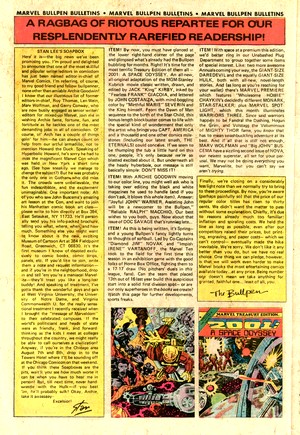 |
|
|
In October 1976, the
Bullpen Bulletin was still on its way
through the alphabet as far as its title
was concerned, arriving at the letter R -
which resulted in the typically
alliterative and somewhat nonsensical
title "A Ragbag of Riotious
Repartee for Our Resplendently Rarified
Readership!". The big news - and
the headline item of Stan Lee's Soapbox
column - was the promotion of Archie
Goodwin to Editor-in-Chief.
Lee also mentioned
the "illustrious list of former
editors-in-chief, Roy Thomas, Len Wein,
Marv Wolfman, and Gerry Conway" but
diligently avoided pointing out that this
position had quickly become a revolving
door affair, with those four gents
successively at the helm between 1972 and
1976 (and Conway only lasting six weeks),
and all of them stepping down to be able
to spend more time writing.
|
|
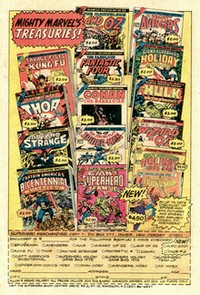 |
Also not
mentioned by Stan Lee on this occasion was the
fact that Archie Goodwin only agreed to fill the
position on the assumption that it would be
temporary, until a permanent replacement could be
found; ultimately Goodwin would resign at the end
of 1977 (Howe, 2012).
|
|
| |
| As for the actual Bullpen Bulletins' various ITEM!
bullet points, they were - as usual - mostly concerned
with new and changing assignments of various writers and
artists, as well as Marvel's ever expanding line of
titles - in this case the major push was given to the
Super Treasury Edition of Kirby's 2001: A Space
Odyssey, an adaptation of the movie. It would be
followed in December 1976 by an ongoing series of the
same title which, however, would find few favours with
readers and be cancelled after a mere ten issues. The final item of news was both bad
and not really news at all - Marvel's need (for reasons
explained in this Bullpen Bulletin in a separate box) to
raise the cover price for their regular comics from 25¢
to 30¢. Following a few tests in select markets to gauge
buyer reactions to the 5¢ hike, the higher price was
introduced as of September 1976 (cover date), i.e. the
previous month. The price for a MARVEL
MULTI-MAGS rose accordingly, to 89¢ for three
comics instead of the previous 74¢.
|
| |
|
| |
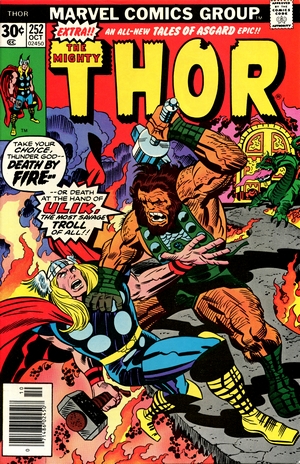
|
|
THOR
#252
October 1976
(monthly)
On Sale:
13 July 1976
Editor
- Len Wein
Cover - Jack Kirby (pencils) & John
Verpoorten (inks)
"A Dragon at the
Gates!"
(11 pages)
Story - Len
Wein
Pencils - John Buscema
Inks - Tony DeZuniga
Lettering -
Joe Rosen, Gaspar
Saladino (splashpage)
Colouring - Glynis Wein
"The Weapon and the
Warrior!"
(7 pages)
Story -
David Kraft
Pencils - Pablo Marcos
Inks - Pablo Marcos
Lettering -
John Costanza
Colouring - Glynis Wein
|
|
|
| |
| In Thor #252, the God of
Thunder, in search of Odin gone missing, battles it out
with Ulik, "the most savage troll of all!"
as the cover blurb puts it (and who appeared previously
in issues of Thor available in MARVEL MULTI-MAGS). However, readers
only got 11 pages of this confrontation, since this issue
(and the next) contained a backup feature: The famous Tales
of Asgard were back. |
| |
As for the regular Thor stories
of this period, Len Wein summed it up nicely in
2016.
"The
legendary Jack 'King' Kirby had introduced
the magnificent scope and majesty of fabled
Asgard, but John [Buscema] added a power and
grace that was uniquely his own. John had a
way of understanding characters that was
positively supernatural in its depth.
In John's stories,
every pose was unique to the character at
hand, every gesture, every expression. No two
characters would ever sit the same in a John
Buscema story, and nobody could put a figure
in a chair like John. You could feel every
ounce of that character's weight as he or she
sat, feel the weighty matters that stooped
their shoulders." (Wein, 2016)
|
|
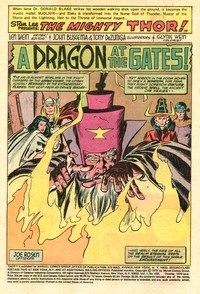 |
|
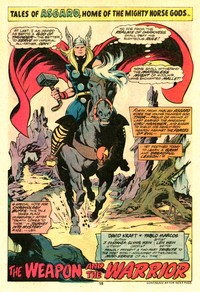 |
|
| |
| Pablo Marcos, who moved from his
native Peru first to Mexico and then to the US in the
1970s, was also an established artist with an
accomplished background in illustration and art, but the Tales
of Asgard segment seemingly didn't thrill readers
enough for Marvel to continue the experiment after the
conclusion of this story in Thor #253. |
| |
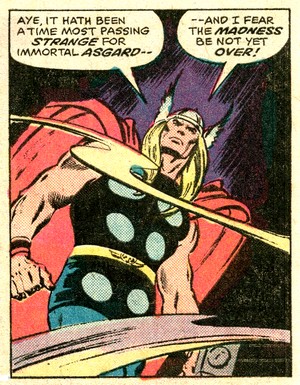 |
|
Incidentally, the Grand Comics Database states that
Buscema only did the breakdowns
for this issue of Thor and that Tony
DeZuniga provided the finished art.
But regardless of how much Buscema and how much
DeZuniga ended up in the finished product, there
are, as always with issues of Thor from
this period, some truly classic vignettes to be
found and admired.
The cover for Thor #252
can easily be recognized as Jack Kirby's work.
However, and again according to the GCD, Thor's face was reworked
by John Romita & John Verpoorten. It was
understandable in the case of DC, when Kirby
joined them from 1970 to 1975 and his renditions
of Superman didn't conform to the
"established DC visuals", but in this
case Kirby did actually create and shape the
classic 1960s "Thor visuals".
Maybe it was just
another sign that Marvel and Kirby would never
really be happy with each other ever again.
The cover would be
used in 2016 for the frontispiece of the 15th volume of
Thor's adventures in the Masterworks
series.

|
|
| |
 |
|
Regular buyers of
MARVEL
MULTI-MAGS would
be able - with a little bit of
luck - to continue reading the
story of Thor and Ulik (as well
as the conclusion to the Tales
of Asgard backup) as
Thor #253 would become available
in a MARVEL MULTI-MAGS the
following month. |
|
|
|
| |
| |
|
| |
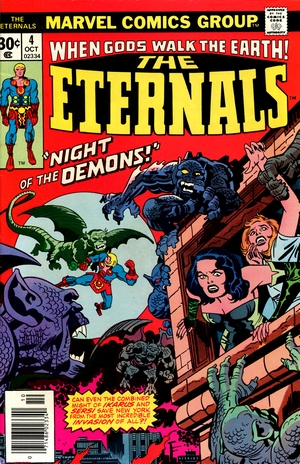
|
|
ETERNALS #4
October
1976
(monthly)
On Sale:
13 July 1976
Editor -Jack
Kirby & Archie Goodwin
(consulting)
Cover - Jack Kirby (pencils)
& Frank Giacoia (inks)
"The
Night of the Demons" (17
pages)
Story - Jack
Kirby
Pencils - Jack Kirby
Inks - John Verpoorten
Lettering - Irv Watanabe
Colouring - Glynis Wein
STORY
OVERVIEW
- The
Deviants continue their assault
of Manhattan, enacting Kro's plan
to manipulate Earth's human
population into becoming their
willing servant soldiers through
the great fear that the Deviants
instil in humans who see them as
Devils and Demons. In the course
of this attack, Kro succeeds in
rendering Ikaris unconscious,
though his body is retrieved from
the ocean floor by Ajak, another
Eternal. Meanwhile, Arishem the
Judge, leader of the Fourth
Celestial Host, continues to
survey the Inca ruins from which
the Celestials were summoned by
the Cosmic Beacon.
|
|
|
|
| |
| Most of the time, the Eternals
were a fun read, though they could be a real mouthful
too. But in order to fully understand the Eternals, one
needs to understand the enormous amount of Jack Kirby's
personal and professional history tied into this title. Kirby left Marvel Comics in 1970 for
DC Comics, increasingly angered by what he perceived to
be an intentional and continuous denial of credit for his
share in creating much of the Marvel Universe. DC
promised him not only full credit but also full artistic
freedom, the result of which was Kirby's "Fourth
World" meta-series, a blend of classic mythology and
science fiction. For some it was the ultimate comic book
saga, while to others it just all seemed too convoluted
and confusing, and the latter group of people seemed to
be in the majority as Kirby's work didn't sell near as
well as DC needed it to. As the number of cancellations
of Fourth World titles grew, so did Kirby's
disappointment with DC, and after his contract ended in
Spring 1975 Jack Kirby once again went to work for
Marvel. In return for this industry scoop, "the
King" essentially just wanted to be left alone to
write and edit his own stories with no co-plotters or
tie-ins with other titles done by other people, keeping
his work deliberately detached from Marvel continuity
(Gartland & Morrow, 2013).
|
| |
| In terms of new concepts, Kirby
started working on The Eternals, which was
thematically similar to his DC work (especially
the New Gods) but actually took its core
inspiration from Swiss author Erich von
Däniken's Chariots of the Gods - in
which the author made the both fascinating and
controversial claim that Earth had been visited
by aliens in the past and that evidence of this
could be found in artefacts and the mythologies
of ancient civilizations. Working
on this premise, Kirby postulates such an alien
visit in our prehistoric past. Through genetic
experimentations these "Celestials"
create three distinct species: Earth's humans,
the "Deviants" (whose genes are so
unstable that every one of them is grotesquely
different and they all have lived on the bottom
of the ocean for centuries), and the
"Eternals" (undying and beautiful
humanoids with superhuman mental gifts).
|
|
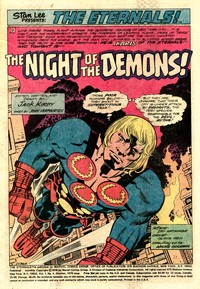 |
|
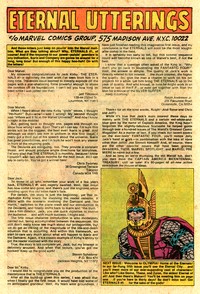 |
|
| |
Kirby pitched the series to Marvel under the title of
The Celestials, but
"Someone at Marvel
felt the new series could piggyback off [von
Däniken's] book's success and changed the title from
The Celestials to Return of the Gods (...) In their
enthusiasm to cash in, Marvel also created a cover
with the new title presented in the same font as the
logo on Däniken's celebrated work. Once someone in
the legal department saw the cover (...) he told
editors "Wait a minute, we're going to get our
rear ends sued off here". The title changed
again, to The Eternals." (Ro, 2004)
|
| |
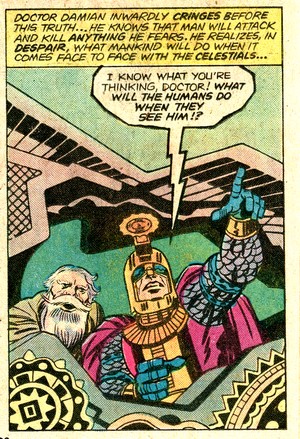
|
|
It was once again
a typically high-flying Kirby
concept, accompanied by artwork
of complex machinery, but at
least to start with it seemed to
work well enough. Although of
course a matter of taste, a
certain "looseness"
seemed to plague Kirby's work
since his return from DC. His
plotting would sometimes go off
in more directions than most
readers were willing to accept
let alone care for, and even his
artwork at times showed signs of
coming undone (compare the hands
in these two panels here from Eternals
#4, separated only by a single
page). Ultimately,
his work came across as being too
detached from what the average
reader would expect. And since
Marvel Comics had always been
about finding "the formula
that sells", this became a
problem, aggravated by the fact
that by that time Kirby was
living and working in California
and the Marvel offices were in
New York.
|
Communication
was slow, and it seems
that opinions on Kirby's
work started to drift to
extremes - some still
admired it, while others
simply couldn't stand it
(Gartland & Morrow,
2013). By
the time Eternals
#4 hit the news stands,
Kirby was still building
his cast and plotting out
the general theme, and
the letters page was full
of praise for the first
issue, with readers
rejoicing about his
return to Marvel and
expecting big things.
|
|
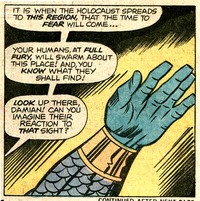 |
|
|
|
|
| |
For some editors at Marvel, that initial enthusiasm
waned rather quickly.
"In addition to
disliking the dialogue (which was sometimes ludicrous
but always earnest, as in the scene [from Eternals #5]
when an innocent bystander ran through crowded
metropolitan streets yelling "Run! Run! The
Devil's come back from space with an army of
Demons!"), they wanted more renowned Marvel
heroes in the book." (Ro, 2004)
So Kirby tried to appease his
critics by linking the Eternals to the Marvel Universe,
but explaining the presence of the Hulk as an instance of
an android robot (allowing him to still keep things
somewhat apart) only frustrated them more. An increasing
amount of corrections of dialogue made in NYC (with Kirby
only finding out when he saw the printed copies) made the
situation more and more difficult. When Kirby's contract
came up for renewal in April 1978, Stan Lee made it clear
that he only wanted Kirby's artwork and no more of his
scripting (Howe, 2012). Not surprisingly, Kirby left
after only three years at Marvel, went to work for the
animation industry, and never returned to Marvel again.
|
| |
|
It is probably fair to say that
all of Kirby's 1970s work is something of an
acquired taste, but the Eternals are
comparatively accessible and make for
entertaining reading most of the time.
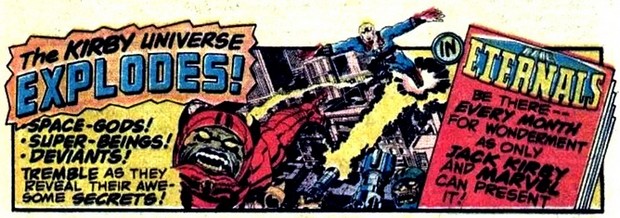
|
|
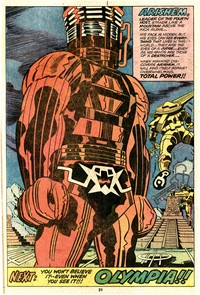 |
|
| |
| |
 |
|
Copies
of the Eternals
appeared frequently in
MARVEL
MULTI-MAGS, and although
the evidence available at this
point in time continues to
present some holes in the data,
Marvel's MULTI-MAGS may
even have carried a complete and
full run of all 19 issues. |
|
|
|
| |
| |
|
| |
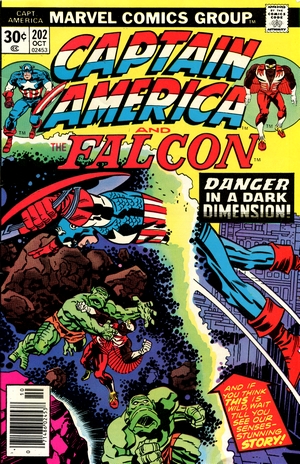
|
|
CAPTAIN
AMERICA #202
October
1976
(monthly)
On Sale:
13 July 1976
Editor -Jack
Kirby & Archie Goodwin
(consulting)
Cover - Jack Kirby (pencils)
& Frank Giacoia (inks)
"Mad,
Mad Dimension!" (17
pages)
Story - Jack
Kirby
Pencils - Jack Kirby
Inks - Frank Giacoia
Lettering - John Costanza
Colouring - George Roussos
STORY
OVERVIEW
- Falcon
has disappeared, and oil magnate
and altruistic adventurer
"Texas Jack" Marshall
Muldoon believes that it has to
do with "Zero Street" -
which has mysteriously vanished
too, including its asylum and its
most notorious inmate, one Dr.
Abner Doolittle, a nuclear
physicist, who apparently
perfected his dimension machine,
transporting the asylum. Muldoon
is actually spot on, since this
is exactly what happened to
Falcon, who is now battling a
monster in said dimension.
Meanwhile, when a strange
fireball portal appears at what
once was Zero Street, Cap leaps
through it, followed by Texas
Jack...
|
|
|
|
| |
| As mentioned above, when Jack
Kirby returned to Marvel in 1975, he really just wanted
to be left alone to write, draw and edit "his own
thing", and Captain America and the Black Panther
were the only Marvel characters (which of course he had
co-created) that Kirby agreed to return to, but here
also, he deliberately detached them from Marvel
continuity (Gartland & Morrow, 2013). |
| |
Kirby took over
with Captain America #193 and a story
arc entitled Madbomb. The cover sported a blurb
reading "King Kirby is back - greater
than ever!" and the promotional copy
for this issue screamed
"King Kirby
is back to bring you an all new action-packed
issue! "Madbomb" - can it really
destroy the earth? Can Cap and Falc save the
world? Read to find out!"
Madbomb followed on the
heels of an extended run by Steve Englehart, who
had firmly linked Captain America to frequent
political and social commentary. Jack Kirby's
take was an entirely different one, portraying
Steve Rogers as a patriot whose all-out action
was his social commentary, all for the good of
the nation.
|
|
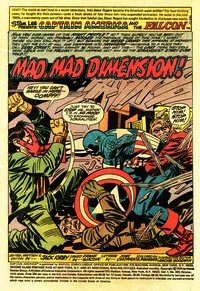 |
|
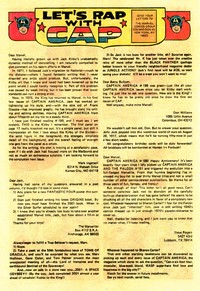 |
|
| |
| Kirby conceived this plot as an eight chapter arc,
leading up to the anniversary #200 issue of the title,
which was quite a daring concept back in 1976. And while
the artwork was your essential Kirby - square-jawed faces
and two-fisted action - his plotting just seemed to run
away with him as everything came and went so fast that it
was hard to follow at times. Adding to this the fact that
nothing of what happened in Captain America
seemed to affect the Marvel Universe at all (which was
exactly how Kirby wanted it to be), it all felt
increasingly weird to many Marvel fans (Gartland &
Morrow, 2013). "Madbomb"
was followed by the story arc "Night People",
of which this issue is its second instalment.
|
| |
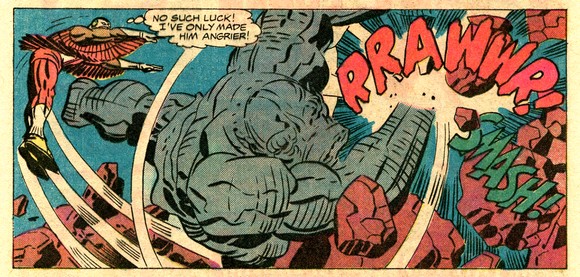
|
|
Marvel was trying
to sell Kirby's Captain America
as a "startling new
concept" (cover blurb
on Captain America #208), but
more and more negative letters
from readers were received (and
published) which in general
praised his artwork as being
superb but qualified his writing
as appalling (Ro, 2004). Gartland
& Morrow (2013) claim that
this was to a degree fabricated
by people inside Marvel wanting
to bully Kirby out, while Howe
(2012) quotes an unnamed Marvel
staffer who snuck self-penned
positive letters into Kirby's Captain
America issues to try and
counter-balance all the negative
feedback pouring in.
|
| |
|
|
|
|
|
Jim Shooter, who
would become Marvel's
Editor-in-Chief in January 1978,
would later add dismal sales
figures of the title to the
commotion:
"We
had single-digit sales
figures for Captain America,
and at a time the Marvel line
average was up near fifty
percent." (Ro,
2004)
When
Marvel called Kirby to tell him
about the low sales and that he
would have to work with the New
York editorial staff and a
dialogue writer, Kirby (who also
refused to at least have Cap
fight well-known and
fan-favourite villains) replied
that he'd rather leave the book.
Jack
Kirby's run on Cap ended with Captain
America #214 (October 1977),
after which Roy Thomas and George
Tuska took over and practically
rebooted the series with a
complete retelling of Captain
America's origin. It was almost
painfully evident that Marvel
wanted its star-spangled hero
back.
|
|
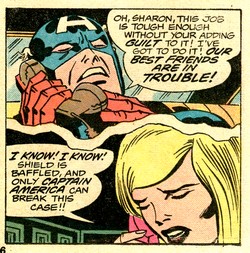 |
|
|
|
| |
| |
|
| |
| |
 |
|
Today,
any MARVEL MULTI-MAGS is a time
capsule; opening this plastic bag
right here offers a nostalgic
glimpse into what it was like to
be a comic book reader in October
1976.
So what else
was going on back then?
|
|
|
|
| |
 |
|
The US
Billboard Chart saw three
number 1s during October
1976: Walter
Murphy and the Big Apple
Band with "A Fifth
of Beethoven" as
well as Chicago with
"If you leave me
now" for one week
each, while Rick Dees and
His Cast of Idiots got
two weeks at the top with
"Disco Duck (Part
1)". In the
UK, ABBA with
"Dancing Queen"
and Pussycat with "Mississippi"
topped the charts for two
weeks each - clearly not
reflecting at all the
fact that 1976 was the
year that Punk Rock
exploded onto the British
music scene. |
|
|
|
| |
 |
|
The New
York Times Bestseller
list for October 1976 was
topped by Leon Uris'
"Trinity", a
spot he occupied since
June; by the end of
October, however, the
number one position would
go to Agatha Christie's
posthumously published
last Miss Marple book,
"Sleeping
Murder".. |
|
|
|
|
| |
 |
|
In
October 1976 John
Schlesinger's
"Marathon Man"
was the most popular
movie in the US. Overall,
"Rocky" was the
US top-grossing movie
while "Jaws"
(which had been released
in 1975 in the States)
topped the 1976 list in
the UK. |
|
|
|
|
| |
 |
|
In the
US, all of the three most
popular TV shows came
from ABC, with
"Happy Days"
taking the top spot.
Numbers for the UK are
sketchy, but it appears
that the TV premiere of
James Bond's
"Goldfinger"
got the most viewers to
sit down in front of the
telly. |
|
|
|
|
| |
| |
|
|
| |
|
FURTHER
READING ON THE THOUGHT
BALLOON |
| |
| |
 |
|
"Comic
packs" not only sold well
for more than two decades, they
also offer some interesting
insight into the comic book
industry's history from the 1960s
through to the 1990s. There's
more on their general history here. |
|
|
|
| |
 |
|
There's more
on the background and the history
of the Marvel Multi Mags here. |
|
|
|
| |
 |
|
There's more
background information and
discussion of the "yellow
and green on white (3 comics for
89¢)" label MARVEL MULTI-MAGS here. |
|
|
|
| |
| |
|
| |
BIBLIOGRAPHY
| |
| |
|
BREVOORT
Tom (2007) "Marvel Multi-Mags", Blah Blah
Blog, originally published online 28 April
2007, reposted 18 April 2020 GARTLAND Mike
& John Morrow (2013) "You can't go home again - Kirby's
1970s return to the "snake pit" of
Marvel Comics",
in Jack Kirby Collector #29
HOWE
Sean (2012) Marvel Comics - The Untold Story,
Harper Collins
RO
Ronin (2004) Tales to Astonish - Jack Kirby,
Stan Lee, and the American Comic Book Revolution,
Bloomsbury
WEIN Len
(2016) "Introduction", Marvel
Masterworks: Thor, Vol. 15
|
|
| |
| |
|
| |
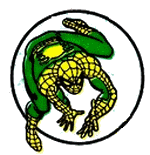



|
| |
|
| |

(c) 2021-2023
uploaded to the web
11 December 2021
minor corrections 19 August 2023
|
| |
|
| |
|


